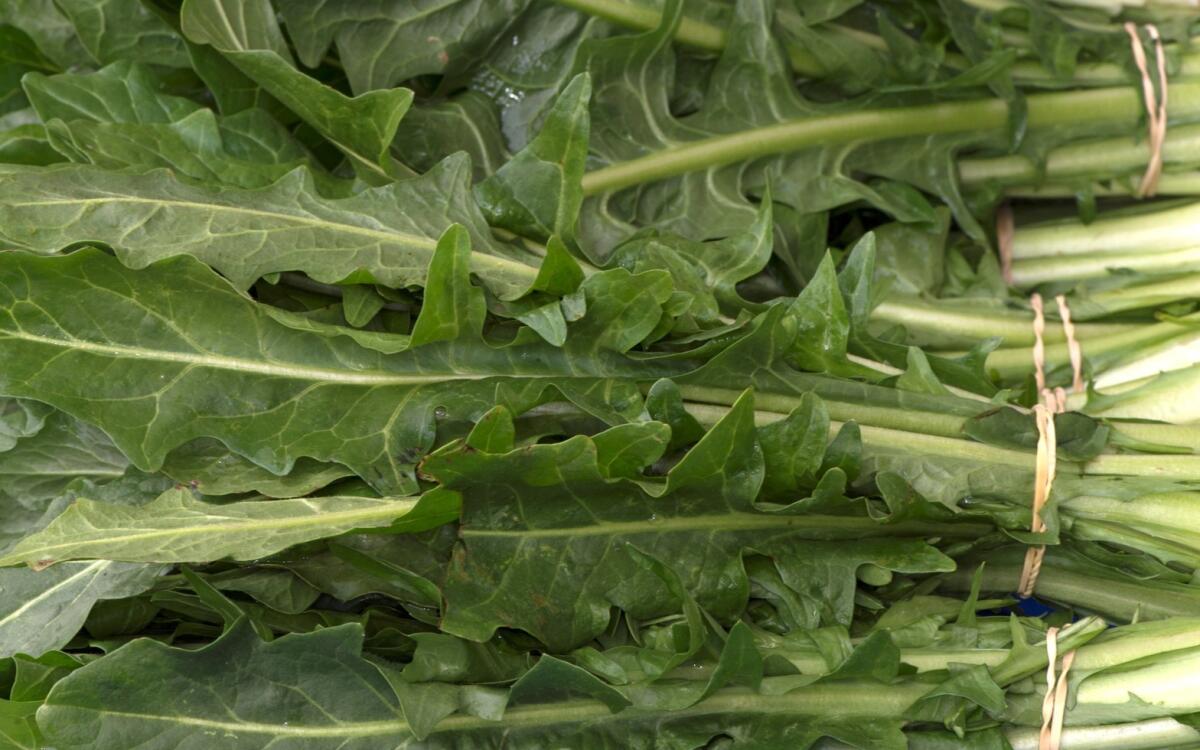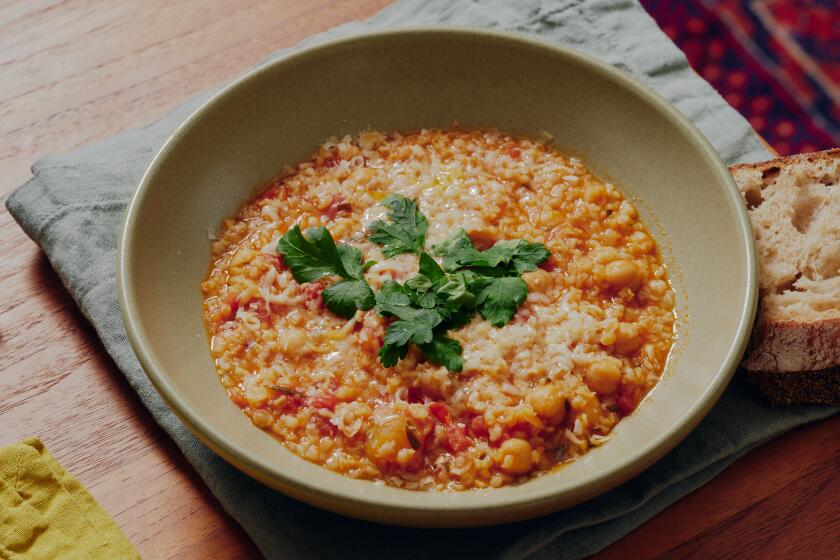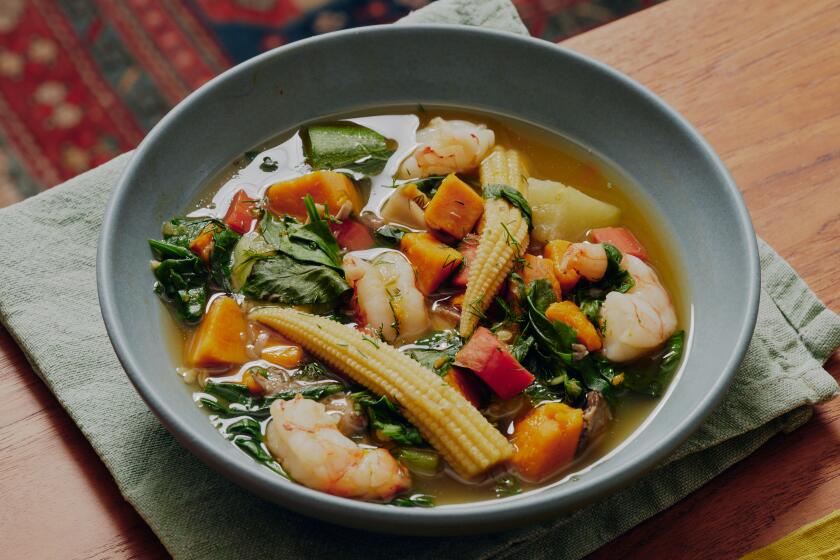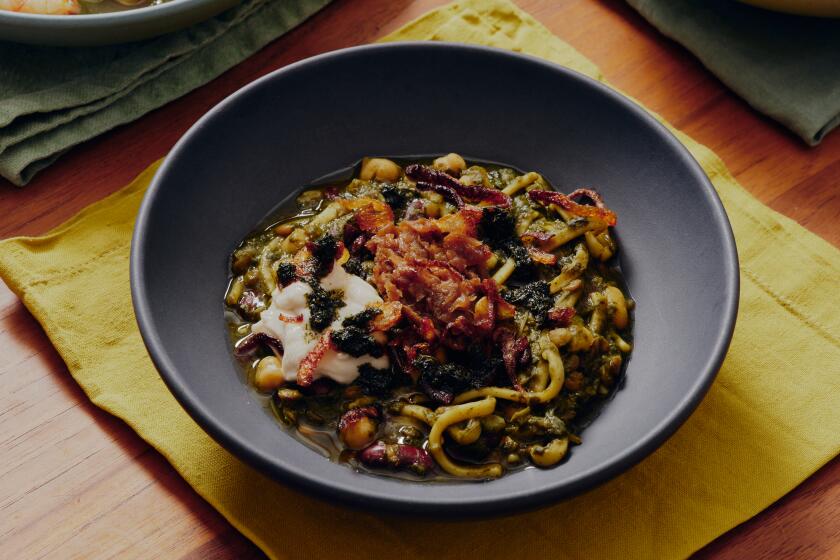White Bean and Ham Soup With Dandelion Greens

Remember when Euell Gibbons made the Johnny Carson show just by claiming, har-har, that dandelions were edible? What a goof he was!
Well, guess what. My local supermarket has had big stacks of dandelion greens in stock all winter. Truly, nothing is too weird to show up in the American produce department these days.
When I started cooking-shortly after the introduction of gas stoves, it now seems-it was quite an event to be able to find red bell peppers. Each summer, Iâd order a case from my friendly grocer, roast and peel them in one blazing backyard briquette orgy and then freeze them to last the rest of the year.
Just this winter-and not including farmers markets-I have seen cavolo nero (a kind of Tuscan kale), fresh black-eyed peas, lotus root, puntarella (a deliciously bitter vegetable, something like celery), pummelos, Jerusalem artichokes and Brussels sprouts on the stalk. Oh yes, weâve had red bell peppers too-completely out of season.
My local market, which seems to cater to black and Hispanic clienteles (I can get both fresh masa and virtually every smoked pork product known to man), has always carried a good assortment of greens: kale, collard, mustard, Texas mustard (paradoxically, itâs somewhat frillier and more delicate). But this winter, dandelions joined the mix.
They look just like the ones you find in your yard, provided you have very rich soil and havenât mowed since, say, the Carter administration. The leaves are roughly eight to 10 inches long, andslender, with the familiar sharply serrated âtoothyâ pattern on the leaves (our word dandelion comes from dent de lion, French for âtooth of the lionâ). Theyâre a dark, vivid green and seem to hold up remarkably well in storage. After a full winter of buying them, I have yet to see wilted tops. Iâve learned to check the bottoms of the stems-thatâs where they seem to begin to fall apart.
I cook them the same way I cook any other bitter green. Theyâre best either with big, forceful flavors, like garlic or anchovies, or played against bland things, like pasta or toasted bread bruschetta. Or with a bean soup, like this one.
Bean soups are a staple of my cooking this time of year. Theyâre hearty and full of the kind of earthy flavor that seems perfect when the weather is gray and clammy. They are also almost infinitely adaptable. As with this recipe, you can make bean soup with ham or some other smoky pig part (hocks are particularly good; include a whole one while the soup is cooking, then retrieve it and shred the meat, being sure to include a little of the fatty skin when you add it back to the pot). Or you can make it vegetarian with an olive oil base.
Whichever way you choose, the important thing to remember when cooking bean soup (or any other kind of dried bean-based recipe, for that matter) is too take your time. Hereâs why: A bean is essentially a big collection of starch granules wrapped in cellulose skin. As the water heats, it softens and expands the starch granules, which in turn allows the water to penetrate more deeply into the bean, softening it further. This process has to go very slowly for the starch granules to soften evenly. So start with cold water and never let the temperature get much past a simmer. Itâs easiest to do this in the oven, where the heat is easier to moderate than on top of the stove.
If cooked too quickly, or overcooked, the beans will break apart. In fact, most beans will split right in half. This happens for the same reason that overcooked rice explodes at the ends. In both cases, the too-rapid or too-thorough expansion of the starch is most notable right at the spots where the covering is the thinnest-where the grains or legumes are most able to absorb water. In the case of rice, that is at either end of the grain. With beans, it is at a small scar in the center called the hilum.
I canât write all of this about bean soup without thinking of a dear friend whose favorite awful joke, delivered in stentorian tones, goes like this: âA man calls the waiter over to his table and points at his bowl. âYoung man, what do you call this mess,â he says. âWell,â says the waiter, âitâs bean soup.â âI donât care what itâs been,â the man bellows, âwhat is it now?ââ
As delicious as it is, something tells me âitâs bean soup with dandelionsâ would not make that particular customer any happier.
*
Parsonsâ book âHow to Read a French Fryâ will be published in May by Houghton-Mifflin.
Heat the oven to 350 degrees.
Heat the ham in a large, heavy oven-proof soup pot over medium heat. Add the carrots, cover and cook 5 minutes. Add the onion, cover and cook until soft, stirring several times so they donât stick to the bottom, about 10 more minutes. Add the beans, water, 1 teaspoon salt and bay leaves, cover and bake until the beans are quite tender, about 2 hours.
Chop the dandelion greens, remove the soup pot from the oven and stir in the greens. Replace the cover and set aside, off heat, until the greens have softened, about 10 minutes. Remove the bay leaves. Season to taste with pepper and salt, though the latter probably wonât be necessary because of the ham.
Get our Cooking newsletter.
Your roundup of inspiring recipes and kitchen tricks.
You may occasionally receive promotional content from the Los Angeles Times.
















